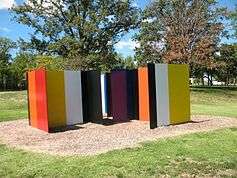Tony Rosenthal
| Tony Rosenthal | |
|---|---|
| Born |
Bernard Rosenthal August 9, 1914 Highland Park, Illinois |
| Died |
July 28, 2009 (aged 94) Southampton, New York |
| Nationality | American |
| Education | University of Michigan, Ann Arbor, Michigan |
| Known for | American abstract sculptor. |
| Movement | American abstract expressionism |

Bernard J. Rosenthal (August 9, 1914 - July 28, 2009),[1] also known as Tony Rosenthal, was an American abstract sculptor.
Biography
Tony Rosenthal was born August 9, 1914 in Highland Park, Illinois, a suburb of Chicago.[2][3] After attending sculpture classes at The Art Institute of Chicago in the early 1930s, he attended the University of Michigan in Ann Arbor, where he graduated with a B.A. in 1936. He also studied with Archipenko in Chicago that year, and in 1939 attended the Cranbrook Academy of Art in Bloomfield Hills, Michigan, where he studied with Carl Milles.
From 1942 to 1946, he served in the US Army, attending the Corps of Engineers Officer Candidate School in Virginia. Later he became a unit commander in England. In 1945, he taught at American University for the education of GIs in Biarritz, France.
In 1953, Rosenthal taught at the University of California, Los Angeles, CA
He died in Southampton, New York on July 28, 2009. He is survived by his wife, Cynthia Dillon Rosenthal.
Works

Rosenthal was best known for his large outdoor geometric abstract sculptures. His works in public places include:
- Nubian Slave, installed at the 1939 New York World's Fair
- The Family Group, Parker Center Los Angeles, California 1955
- Alamo, Astor Place, New York City, 1967. This "established him as a master of monumental public sculpture, and something of a standard bearer of the contemporary structurist esthetic."[4] He stated: "It is…important to me that the sculpture interact with the public."[5]
- Endover, a replica of the Alamo cube, at the University of Michigan in Ann Arbor, 1967
- Odyssey I, Open Air Museum of Sculpture, Antwerp, Belgium, 1967
- Kepaakala (Sun Disc), Bank of Hawaii, Honolulu, Hawaii, 1969
- Rondo, 59th Street off Park Avenue in New York City, 1969
- Odyssey III, San Diego Museum of Art, California, 1973
- 5 in 1, Lower Manhattan, New York City, 1973–74
- Big Six, 1975, The Chrysler Museum of Art, Norfolk, Virginia, 1975
- Hammarskjold, Fashion Institute of Technology in New York City, 1977
- House of the Minotaur, Laumeier Sculpture Park, St. Louis, 1980
- Marty's Cube, at the Florida International University in Miami, 1983
- Pass-Thru, Hofstra University, 1988
- Indiana Totem, 1989, Circle, 1987, J.S. Bach Fugure, 1991, Indiana University Art Museum, Bloomington, Indiana[6]
- JS Bach Variation #9, Ravinia Park, Highland Park, 1990
See also
- Harold Harby, Los Angeles City Council member who denounced Rosenthal's statuary for the Los Angeles Police Building
- Earle D. Baker (1888–1987), Los Angeles City Council member who introduced a resolution to remove the Los Angeles Police Building statuary
References
- ↑ Grimes, William, Tony Rosenthal, Sculptor of Public Art, Dies at 94, New York Times, July 31, 2009.
- ↑ Tony Rosenthal (New York, NY : Rizzoli, 2000.) ISBN 0-8478-2316-4 pp. 58-67
- ↑ American Abstract Expressionism of the 1950s An Illustrated Survey, (New York School Press, 2003.) ISBN 0-9677994-1-4. p.293
- ↑ Tony Rosenthal (New York, NY : Rizzoli, 2000.) ISBN 0-8478-2316-4 p.6
- ↑ American Abstract Expressionism of the 1950s An Illustrated Survey, (New York School Press, 2003.) ISBN 0-9677994-1-4. p.290
- ↑
- Hunter, Sam, Tony Rosenthal, Rizzoli International Publications, Incorporated, 2001, ISBN 0-8478-2316-4
- Wight, Frederick S., Bernard Rosenthal, New York: Catherine Viviano, 1958.
- Marika Herskovic, American Abstract Expressionism of the 1950s An Illustrated Survey, (New York School Press, 2003.) ISBN 0-9677994-1-4. pp. 290–293
- http://www.27east.com/story_detail.cfm?id=226187
- http://www.easthamptonstar.com/dnn/Archive/Home20090806/Obituaries/tabid/9613/Default.aspx